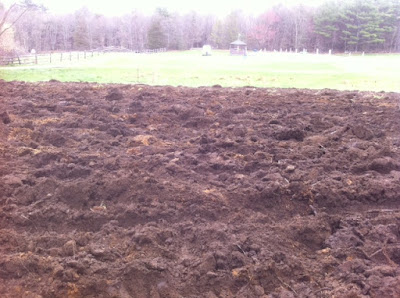I guess I should start at the beginning…
We found a guy to plow our fields over a month ago, and we were hoping that he could come last Monday to do the initial sod-flip with his mold board plow. A mold board plow cuts the sod and then flips it over, exposing the loam and allowing the organic matter in the grass to rot beneath the surface and enrich the soil.
This picture shows a double bottom mold board plow (double because it has two mold boards).
Anyways, we thought we were all set to have the field plowed and then, at the beginning of last week, things started going wrong. The tractor broke — it had to be taken up to New Hampshire to be fixed — and meanwhile it kept raining and raining, soaking the fields and making them increasingly difficult to plow even if we had had a working tractor. Finally, after waiting on the edge of our seats all week, the tractor was brought over last Friday and we watched as it plowed a couple passes along the bottom of the field. We went to bed content and certain that we would have beautifully plowed fields by Saturday afternoon.
I’m starting to learn that every time I go to bed content and certain it means that something’s about to go wrong.
We woke up Saturday morning bright and early. Dave headed down to the field and I lagged behind, taking my time, totally calm. By the time I got outside, 20 minutes behind Dave, disaster had already struck. The tractor had hit a rock, a really big one, and the force of the impact had stopped the tractor short and thrown the driver hard against the steering wheel. It had also bent his plow. The driver was pretty shaken by the whole thing but we slowly convinced him to try another pass with promises of whiskey when the whole thing was over (apparently if a tractor hits a rock like that hard enough it can flip the whole machine — so he had good reason to be freaked out). So he got back on his tractor and came around for another pass, he hit another rock almost immediately. It was over, with less than a quarter of our first field turned. Saturday morning 7:45 AM, already a week behind schedule, and we were back to the drawing board.
I’m not sure why we were so surprised by this particular problem. After all, New England is pretty famous for it’s rocky fields, and Carlisle is especially famous for being difficult to plow. We’ve been told by multiple people that the reason Concord was settled first was because its soils are clean and clear, while Carlisle is all either swamp or rock ledge. But for some reason it hadn’t really crossed our minds that we might hit huge rocks in the middle of our field. This was partially because the nearby stone wall had convinced us that the pioneers had already taken care of all the hard stuff and also partially just plain old wishful thinking.
So, we started calling everyone that we could think of that might have an opinion, or a tractor, and after reviewing a bunch of different options, it became clear that the major problem was that the tractor was only 2‑wheel drive. It was too small, and therefore hadn’t been able to go slowly enough to drag the plow safely. In addition, some mold board plows are spring-tripped. When the plow hits a large rock, instead of stopping the tractor short, the spring on the plow breaks and swings it up and back, preventing the plow (and the driver) from being damaged. A 4‑wheel drive tractor with a spring-tripped plow could creep through the field, finding the rocks without causing harm to the plow or the driver. But then what to do about the rocks? It might have seemed fine to leave them, as long as they were 6 inches down or more, but apparently once you start loosening up the soil the rocks start to rise more quickly. We needed to get them out or get stuck with a field full of boulders.
Luckily, Dave’s parents are building a new trailer parking lot next to our new field, and so there was a huge excavator stationed right next door. If we could find a 4‑wheel drive tractor, than we could slowly plow the field, and every time the tractor hit a rock, Rick could come in with his excavator and dig it out. By calling around we found a handful of different guys willing to do the job, but there was an easy winner. One of Dave’s parent’s friends happens to own all the equipment we needed (he uses it to turn and re-seed horse pastures) and he was willing to lend it to us for free and let Dave plow the fields himself. The offer was too good to turn down.
So, Monday morning (exactly one week behind schedule) Dave and I went down to the fields and he plowed the whole thing (with no previous experience!). It took him a couple passes to get used to it, but we managed to turn over a pretty consistent 6″ to 8″ of sod and soil. Rick moved all the big rocks (there were A LOT) and we tried to take care of the little ones. It may not have been the prettiest or more efficient plow job, but it is our blood and sweat all over the field, and that’s nice to know.
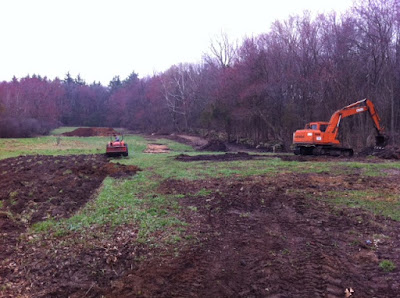 |
| The first field |
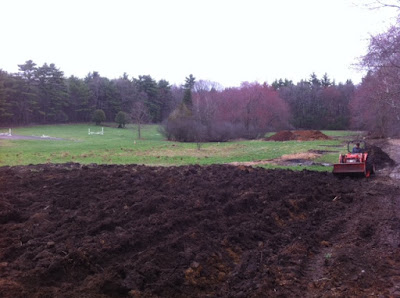 |
| Finishing up the first field |
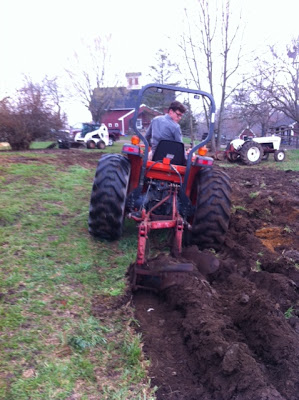 |
| Double bottomed mold board plow at work |
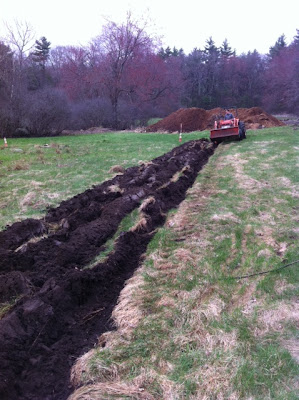 |
| Starting the second field (soil looks great!) |
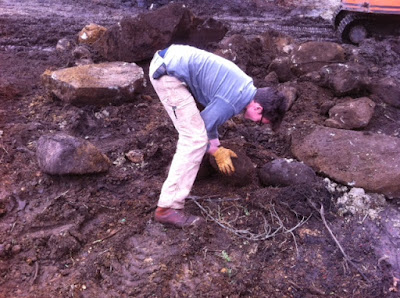 |
| Movin’ rocks |
It was pretty exhausting and not very easy. In the first field we hit a rock on almost every pass. And some of them were enormous. I followed behind the tractor and marked any problem areas so we could go back and suss out the situation. It makes you think about those pioneers dragging those things out with horses. The second field had a lot less rocks. The stone wall kind of peters out as it gets nearer to the house, so we think maybe the pioneers either ran out of steam or didn’t need all that area for agriculture.
The good news is that we got both fields done by 2 PM on Monday. The bad news is that we are now pretty seriously behind schedule. The sod is very very thick and dense, probably owing to the fact that this field has lain fallow for so long. It’s been recommended that we allow 2 weeks for the sod to rot and then go back and disk the whole thing, breaking up the soil and making it plantable. After that we’re supposed to wait another 10 days before we start putting seeds in (to allow the sod to rot some more). That schedule means we won’t be planting until mid to late May, which is too bad since we were planning on starting May 1st. We do have a smaller kitchen garden in the works, however, so hopefully between that and the greenhouse we should be able to keep growing and be totally ready to plant whenever the field is. The other bad news is that we had to let the excavator drive onto our field in order to get the rocks out. We’ve been trying very hard to not compress the soil, as this can squeeze out oxygen and water and suffocate and crush a lot of the helpful microbes and life in our deep organic matter. We can only cross our fingers and hope that we haven’t done too much damage, and that our soil can spring back to health by planting time.
